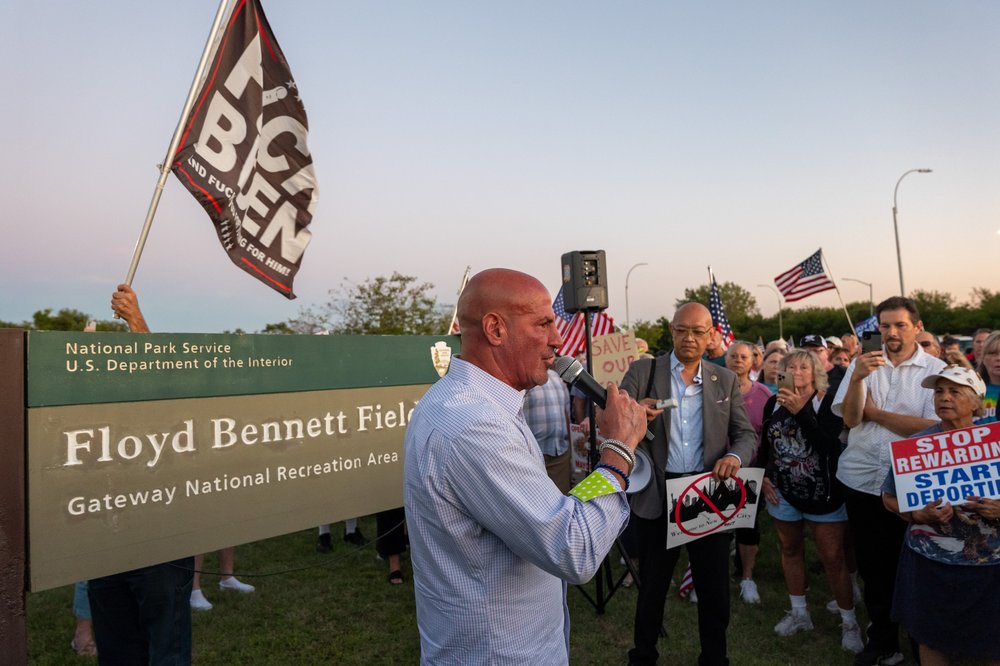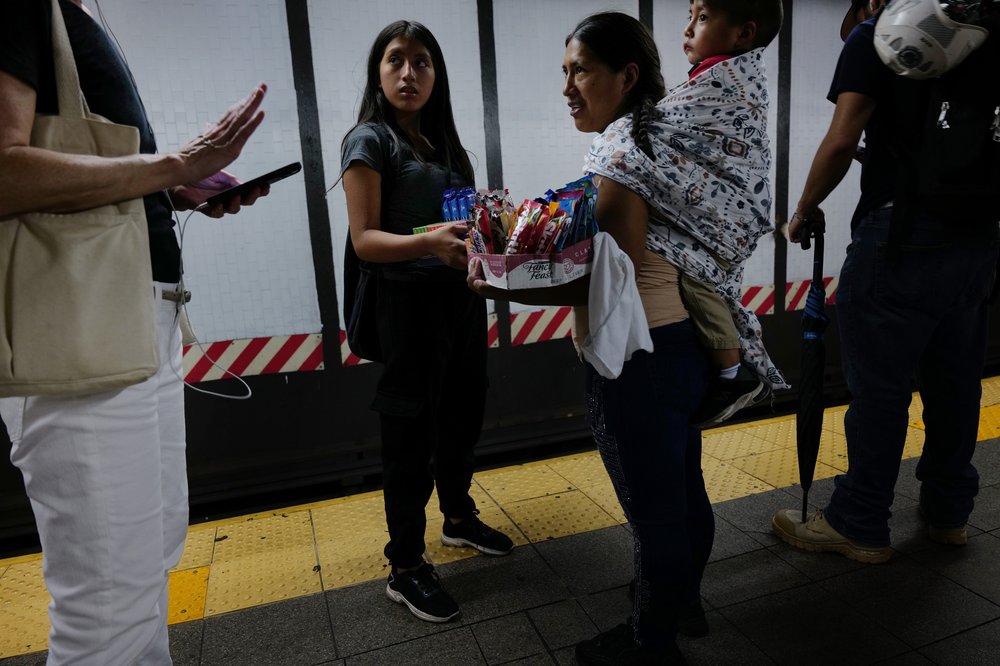Migrant students face schooling uncertainty as NYC gives families 60 days to exit shelter
Nov. 3, 2023, 7 a.m.
Many migrants families face a deadline around Christmas to leave the shelter system, raising questions about where their kids will go to school.

Migrant families notified they have 60 days to leave the city’s shelter system say they’re worried their children’s education will be upended as they seek a roof over their heads just as schools break for Christmas.
Families staying at the Row — a Midtown hotel that was converted into a shelter last year — said notices in various languages are papered along hallways, warning that staff will be notifying them when they must leave. They said shelter staff began knocking on doors last week, handing out 60-day notices and referring them to a social worker for help finding another place to live. The first recipients of the notice face a deadline to leave right around the Christmas holiday.
Others say they’re anxiously waiting for the knock on the door and haven’t received any answers about what relocating means for their school-aged children.
“My kids tell me they don’t want to change schools because they have their friends and they love their teachers,” said Reyna Perez, who has been living with her three children at the Row. “They’re doing really well.”
City officials said 250 of the 60-day notices have been issued across shelters so far. Migrants have the option of reapplying for shelter. The policy previously applied just to single adult migrants, and was extended to migrant families last month.
Education and child advocates say the new shelter limits will force families to make difficult choices about keeping their children in their current schools while finding a new place to live. The advocates fear this will result in students facing longer commutes to get to school – or simply not showing up to class. Parents will also have the option of enrolling their kid in a new school. But many migrant parents and kids said they did not want to leave their school community.
Mayor Eric Adams insists the new rules won’t destabilize children’s education and federal rules guarantee homeless students the right to stay in their school even if they move shelters. “No child is going to be displaced or their school is going to be interrupted. Every child will remain in their school,” he said at a press briefing late last month.
Meanwhile, the city’s school bus system is grappling with a bus driver shortage and delays. That could add to the instability affecting migrant students who often come to the U.S. with gaps in their schooling, don’t speak English and already struggle to keep up.
Advocates, including the Legal Aid Society, are further alarmed by the logistical challenges facing migrant families sent to the shelter expected to soon open at Floyd Bennett Field. It’s unclear how students at the isolated site at a former airport in Jamaica Bay will get to school on time. The shelter, which will house migrant families who have just arrived in the city, also doesn’t have private areas for kids to do homework.

Perez said she has until Dec. 31 to move out of the Row, but can’t find an apartment her family can afford. She said some landlords don’t want children. Others say her family of five can’t live in a one-bedroom apartment, which is all she can afford while she and her partner wait for a work permit to secure more stable employment, rather than sporadic construction and cleaning work.
“Our worry as parents is to make sure our kids aren’t going from school to school,” Perez said in Spanish. She worries her two kids will have to leave P.S. 75 in the Upper West Side which offers instruction in Spanish one day and English the next.
“From where we come, they’ve endured many things and we want the best for our kids,” she said of her journey from Nicaragua.
‘A right in name only’
Advocates say forcing migrant families to reapply for shelter every two months will only exacerbate the challenges facing all homeless students. It could also create new pressures on educators and parents helping the newly arriving families, while also complicating federal immigration processes that rely on sending notices through the mail.
“That is not conducive to the kids for their feeling of safety or their ability to learn,” Naveed Hasan, a parent leader at P.S. 145 on the Upper West Side, which has received 130 migrant students over the past year.
Hasan said forcing migrant families to move this winter is not only extremely disruptive for the migrant students, but for the school communities that have been serving them.
“It creates domino effects for the teachers who’ve been doing a lot of amazing work,” he said. “To be told you have to do it all over again every two months is unacceptable.”
According to a report from Advocates for Children released earlier this week, there were more than 119,000 homeless students in city schools last year, a record high, translating into one out of every nine public school students. About 32,000 new students living in temporary housing have enrolled in city schools since July 2022, city schools officials said. Homeless students are more likely to be chronically absent and have higher dropout rates. They also score far lower in reading and math than their peers.
Under federal law, homeless students must have the option to remain in their schools if they choose to, even if they move shelters.
But Jennifer Pringle of Advocates for Children said “this is often a right in name only.”
“Between delays in arranging busing, a shortage of bus drivers, unreasonably long commute times, and other obstacles, parents often feel they have no choice but to uproot their children from schools they love when they move shelters,” she said.
“Regardless of their immigration status or language spoken at home, every student deserves access to high-quality schools that meet their unique needs,” Nicole Brownstein, a spokesperson for New York City Public Schools said in a statement. She said the agency would continue to support newly arriving students and the schools serving them. The city spent tens of millions of dollars last year to support schools receiving migrant students. Officials also revised the per-pupil funding formula last spring to increase funding for students in temporary housing.

Most of the 13,500 migrant families with children under the city’s care reside in shelters run by the Department of Homeless Services, city data shows. The 60-day notices are going to the 4,200 families living in shelters run by NYC Health and Hospitals, though it’s not clear what criteria the city is using to decide which families receive their notice first.
School officials said education coordinators are at emergency migrant shelters and schools to help migrant students.
A transportation nightmare
Families in temporary housing can request school buses for their children in pre-K through sixth grade to help them get to school. But multiple parents have said navigating the bureaucracy to get their children signed up for buses has been extremely difficult. Meanwhile parents have said a bus driver shortage is causing routes to become longer and more inefficient.
“What we are seeing is super problematic,” said Sara Catalinotto, founder of Parents To Improve School Transportation. “We have people getting picked up at 4:30 when school was done at 2:50,” she said.
Catalinotto said it can take weeks for the city to process an address change and put a child on a new route, and she worries students will miss more school as a result.
Parent Lorena Espinoza Castro said she got a notice to leave the Row by Dec. 26. She said she plans to live in Queens with her two daughters and find another elementary school in her neighborhood. But she said her 16-year-old daughter wants to stay at her school in Midtown.
“She’s going to do what’s possible to come to her [current] school,” she said in Spanish. “I love that school, too. I love the teachers.”
Other families are in limbo, waiting to see if they get a 60-day notice next and that’s leaving children wondering whether they’ll be able to stay in their school — where they’ve already memorized which subway to take, bonded with teachers and made friends.
“Everyone is kind, no one is aggressive, I really love my school,” fifth-grader Paola Andreina Jimenez said in Spanish. She said it takes her 25 minutes on the subway to get to P.S. 28 in Harlem from the Row hotel.
NYC to order migrant families with children to leave shelters after 60 days, sources say Migrant surge fuels record number of homeless NYC students